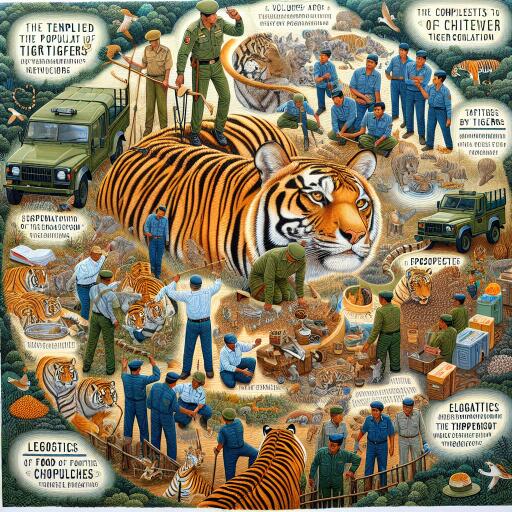
India’s tiger population recovery is a complex work-in-progress
A recent study uncovers the intricate aspects that impact tiger recovery and survival within India. Despite a notable expansion in tiger habitats, local extinctions have persisted due to factors such as urban expansion, human conflict, and poaching. As tigers increasingly share territories with human societies, efforts that encourage sustainable livelihoods, eco-friendly tourism, and advanced conservation technologies are vital to sustain improvements.
India has achieved the notable feat of doubling its declining wild tiger numbers by the year 2022. By analyzing population patterns from 2006 to 2018, the study seeks to decode the socio-ecological drivers influencing tiger resurgence and their continued existence. Sustained population recovery hinges on the delicate balance of conservation initiatives alongside economic benefits for the local populace.
Historically, tigers ruled vast regions across Asia. Alas, rampant poaching, widespread habitat degradation, and human encroachment drove these formidable predators towards near extinction. By the dawn of the 21st century, tiger populations globally dwindled to a mere 3,600, residing in less than 10% of their original expanse.
Responding to the precarious state of tigers, tiger-range countries initiated the Global Tiger Recovery Program in 2010, with an objective to double their numbers by 2022. India surpassed this goal through science-based approaches, solid governmental resolve, and mass public backing. Within the last two decades, tiger occupancy expanded by a considerable 30% within India, currently accommodating 75% of the world’s wild tigers — 3,167 as of 2022 — over approximately 138,200 km².
The study, appearing in a leading scientific journal, brings fresh insights into India’s tiger revival, evaluating population dynamics, habitat interconnectivity, and the principal ecological elements affecting their sustainability. The emphasis has shifted from merely counting tigers to considering population distribution, connectivity, and the factors driving extinction and recolonization.
Habitat Gains and Challenges
From 2006 to 2018, tigers reclaimed 41,767 km² of previously lost habitat in India. The greatest expansion was noted between 2014 and 2018, with an annual average increase of 2,929 km².
Strategies of both preserving vital areas and sharing land have been instrumental in this resurgence. The preservation of core territories ensures sustainable tiger numbers, while conservation efforts in surrounding buffer zones aid in human-tiger cohabitation. This approach supports tiger populations in smaller connecting habitats and maintains genetic connectivity essential for long-term recovery.
Nevertheless, this progress faced hurdles; 17,992 km² experienced local extinctions over 12 years, with the peak losses (64%) occurring between 2006 and 2010. Urban expansion, infrastructure proliferation, and armed conflict were principal causes. Later periods recorded smaller losses — 17% between 2010-2014 and 19% between 2014-2018.
Armed conflicts notably contributed to local tiger population declines, accounting for 47% of these setbacks. Tiger populations have notably suffered in conflict-laden areas. Reserves affected include regions within Chhattisgarh, Jharkhand, and parts of Odisha, Telangana, Andhra Pradesh, and Maharashtra.
Encouragingly, regions where conflicts have subsided, such as certain areas of Andhra Pradesh and Telangana, show promising signs of tiger recovery, underscoring the critical link between political stability and effective wildlife safeguarding.
Facilitating Coexistence
Ensuring tiger survival transcends human population density metrics. The study examined 1,973 surveyed zones with confirmed tiger existence, revealing that 85% of Indian tigers inhabit protected reserves, 4% dwell in habitat corridors, and 11% reside in multi-purpose landscapes outside reserves.
While tigers thrive in prey-rich, human-free zones, they also move toward adjacent territories. In recent reclamations, human presence averaged 250 individuals/km², indicating that economic incentives and cohabitation strategies play larger roles than simply minimizing human activity.
An exemplary instance is Sawai Madhopur in Rajasthan, where tiger tourism supports the local economy. Regions where economic benefits exist see a greater tolerance for tigers, whereas areas dependent heavily on forests face persistent human-wildlife conflicts, heightening extinction risks.
Striking a balance between conservation and sustainable livelihoods is pivotal. Programs promoting ecotourism, sustainable agriculture, and compensation schemes can align economic and ecological goals, ideally transforming protected regions into biodiversity conservation hubs and tools for poverty reduction.
Technological Advancements in Monitoring
India’s conservation strategies have significantly evolved, especially since 2005, when tigers were reported locally extinct in Rajasthan’s Sariska Tiger Reserve. This led to modernized monitoring, leveraging technologies such as camera traps, genetic analysis, and M-STrIPES (Monitoring System for Tigers: Intensive Protection and Ecological Status) to bolster patrolling effectiveness, assess ecological health, and mitigate conflicts.
Modern technology has revolutionized tiger monitoring, ensuring decisions are grounded in reliable data and minimizing falsification risks.
Safeguarding Progress
Despite major advances, any lapse in conservation efforts risks reversing longstanding achievements. Tiger recovery relies fundamentally on available space and prosperity, with vital core habitats underpinning the means to share landscapes.
India’s tiger resurgence offers valuable insights for conserving other global carnivores. Lessons from years of tiger conservation have deepened insights on predator demography, behavior, and habitat dynamics, essential for managing other large predators across varied ecosystems.
Tigers, as keystone species, play a crucial role in ecosystem health, their habitats heavily intersecting those of other species like Asian elephants and leopards. Protecting tigers, therefore, safeguards broader biodiversity.
Continuous investment in strategic conservation policies, habitat safeguarding, and community economic incentives remains critical. Sustainable human development and responsible landscape management are key to securing the future for both human inhabitants and tiger populations.





Leave a Reply